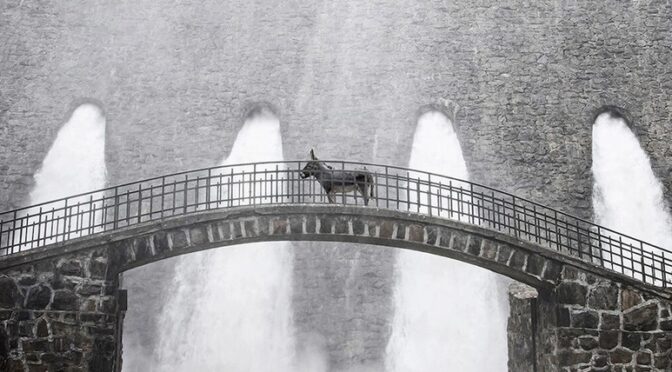EO, directed by Jerzy Skolimowski, joins a recent trend of films from the perspective of a non-anthropomorphised animal. GUNDA (Viktor Kossakovsky) is a wordless film following a pig’s daily life, and Andrea Arnold’s COW follows the life of a dairy cow bred for milking and breeding. Unlike BABE, for example, the animal protagonists in these films are never anthropomorphised: they aren’t made to be human analogues; the films allow them to be animals and seek to expand our sense of consciousness. EO takes a more fanciful approach: whereas GUNDA and COW were documentaries, EO weaves a narrative that pulls us into the subjective view of its donkey protagonist.
EO follows a donkey named Eo (played by Tako, Hola, Marietta, Ettore, Rocco, and Mela) whose life in the circus is disrupted by Poland’s new animal rights laws banning the use of animals in circus performances. Eo is taken from the circus and begins a journey across Poland into Italy, visiting riding stables, farms, football grounds, cemeteries, abattoirs, and the sprawling grounds of a mansion.
EO works by using the language of cinema to pull us into the subjectivity of Eo and the other animals he encounters. The few humans in the film are secondary characters, often treated comically, primarily existing to push Eo into new plot situations. Dialogue is minimal, and the film uses visual language in its place to communicate. Animals are continually framed as subjects within the frame to push us to empathise with the non-humans on camera: as well as Eo himself, there are horses, frogs, spiders, owls, wolves, foxes, bats, tropical fish, pigs, cows, and even an animalistic robot. We are pulled into constructing motives and desires for Eo and the other animals. A close-up of a horse appearing agitated invites us to wonder if they are missing their friend or being forced to do something they don’t want to do. Eo, in the foreground, looks at horses running in open fields in the background, and we wonder if he’s dreaming of freedom. When Eo doesn’t take an offered carrot, is he sad?
“Dialogue is minimal, and the film uses visual language in its place to communicate. Animals are continually framed as subjects within the frame to push us to empathise with the non-humans on camera…”
The use of cinematic language to tell the story extends to music, and EO leans heavily on its score to set the tone and the mood of various scenes. The film’s composer Paweł Mykietyn creates an evocative soundscape ranging over Eo’s emotional highs and lows (one recognised with the Soundtrack Award at Cannes in 2022). Like Eo’s journey, the soundtrack also ventures into Italy with subtle references at the end to Giuseppe Verdi’s Dies Irae from Messa da Requiem.
Despite this focus on animal subjectivities, EO is also layered with human meaning as Eo traverses Poland’s tragic past and conflicted present. Eo wanders through an overgrown and forgotten Jewish cemetery in a forest, a historical relic, followed by a tracking shot over the woods bathed in red light so that a stream looks like a river of blood. The mechanised slaughter of an abattoir further evokes the terrible machinery of the Holocaust that occurred here less than a century ago. Turning to the present, Wrocław’s progressive animal rights reform is contrasted with modern football rivalries that turn into hooliganism and violence.
“Many of the locations that Eo visits revolve around exploiting animals. As we fall deeper into the subjectivity of the non-human, we realise that so many places where we find animals on Earth are built with the express purpose of exploiting them.”
Many of the locations that Eo visits revolve around exploiting animals. As we fall deeper into the subjectivity of the non-human, we realise that so many places where we find animals on Earth are built with the express purpose of exploiting them. EO continually shows animals trapped inside rings to contain them: a circus ring, a horse schooling ring, and a vet’s stable. Even before its disclaimer at the end about the welfare of all the animals featured in the film, it’s clear that the production cares.
Through visual language and a layered narrative, EO uses cinema to more effectively engage us with the subjectivity of an animal protagonist than GUNDA or COW. EO was awarded the Jury Prize at Cannes and submitted as Poland’s entry for Best International Feature at the Academy Awards 2023. The film feels like a milestone for recognition of the consciousness of the beings with whom we share a planet.

